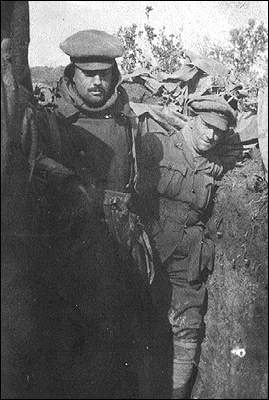Gallipoli
First World War
Date
No date parameters defined.
Geographical parameters
No geographical parameters defined.
Context
A theatre of war honour formally entitled “Gallipoli” with year dates according to the service in each theatre of the unit concerned.Footnote 1
Description
By the end of 1914 the Western Front had stalemated as both sides dug in. As the generals grappled with the difficulty of assaulting fortified positions, other British military planners looked for alternatives. What was eventually decided on was an attempt to force the Dardanelles, the narrow strait between the Mediterranean and the Sea of Marmara, with a naval force to relieve the pressure on the Russians and hopefully cause an Ottoman surrender. When the initial naval attempt failed, troops were landed on the Gallipoli peninsula on 25 April 1915. Although the troops – a mix of French, British, Australians, and New Zealanders – made it off the beaches, they suffered heavy casualties, and this front also stagnated.
In August 1915, the Newfoundland Regiment was ordered to proceed to Gallipoli to join the 88th Brigade, part of the British 29th Division, in the Mediterranean Expeditionary Force. On 20 September 1915, 1,076 Newfoundlanders landed at Suvla Bay and by 30 September, they were in the trenches and responsible for holding 1.5 kilometers (1600 yards) of the front line. Conditions at Gallipoli were difficult, the Newfoundlanders fighting flies and frequently coming under heavy Turkish shellfire – the first fatalities were caused by shells within hours of the regiment coming ashore. There was relatively little offensive action, but, on 4 November, the Newfoundlanders attacked and captured what became known as Caribou Hill to deal with persistent sniping from the position.
Then, in December 1915, after months of stalemate, the evacuation of the peninsula began. After successfully evacuating from Suvla, the Newfoundlanders were redeployed to the south to support the evacuation of the forces there. Because of this, they were among the last units to leave the peninsula. By the end of the campaign, illness and injuries had brought the Newfoundland Regiment down to a strength of only 470 men and 17 officers. They had also suffered 43 fatalities. Footnote 2
The Royal Newfoundland Regiment is the only unit in the Canadian Armed Forces to hold the Gallipoli battle honour.

Headquarters Dugouts, Cape Helles, Suvla Bay.
Photo taken between December 22, 1915 and January 9, 1916.
Credit: Courtesy of the Rooms Provincial Archives Division (VA 37-3.1), St. John's, NL.

Capt. Alexander (left) and Capt. Nunns (right)
of B Company, in front line, Suvla Bay, 1915.
Credit: Courtesy of the Rooms Provincial Archives Division (VA 37-1.3), St. John's, NL.